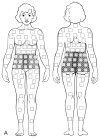Relating pelvic pain location to surgical findings of endometriosis
- PMID: 21775836
- PMCID: PMC3155822
- DOI: 10.1097/AOG.0b013e318223fed0
Relating pelvic pain location to surgical findings of endometriosis
Abstract
Objective: To study whether pain location is related to lesion location in women with chronic pelvic pain and biopsy-proven endometriosis.
Methods: A secondary analysis was performed to compare self-reported pain location with recorded laparoscopy findings for location and characteristics of all visible lesions. All lesions were excised. Endometriosis was diagnosed using histopathology criteria. The pelvic area was divided into three anterior and two posterior regions. Lesion depth, number of lesions or endometriomas, and disease burden (defined as sum of lesion sizes, or single compared with multiple lesions) were determined for each region. Data were analyzed using t tests, Fisher exact tests, and logistic regression modeling, with P values corrected for multiple comparisons using the step-down Bonferroni method.
Results: Women with endometriosis (n = 96) had lower body mass indexes, were more likely to be white, had more previous surgeries, and had more frequent menstrual pain and incapacitation than did chronic pain patients without endometriosis (n = 37). Overall, few patients had deeply infiltrating lesions (n = 38). Dysuria was associated with superficial bladder peritoneal lesions. Other lesions or endometriomas were not associated with pain in the same anatomic locations. Lesion depth, disease burden, and number of lesions or endometriomas were not associated with pain.
Conclusion: In this group of women with biopsy-proven endometriosis, few had deeply infiltrating lesions or endometriomas. Dysuria and midline anterior pain were the only symptoms associated with the location of superficial endometriosis lesions. The lack of relationship between pain and superficial lesion location raises questions about how these lesions relate to pain.
Clinical trial registration: ClinicalTrials.gov, www.clinicaltrials.gov, NCT00001848.
Level of evidence: : II.
Figures



Similar articles
-
Return of chronic pelvic pain from endometriosis after raloxifene treatment: a randomized controlled trial.Obstet Gynecol. 2008 Jan;111(1):88-96. doi: 10.1097/01.AOG.0000297307.35024.b5. Obstet Gynecol. 2008. PMID: 18165396 Free PMC article. Clinical Trial.
-
Surgical Management of Superficial Peritoneal Adolescent Endometriosis.J Pediatr Adolesc Gynecol. 2019 Jun;32(3):339-341. doi: 10.1016/j.jpag.2019.01.005. Epub 2019 Jan 29. J Pediatr Adolesc Gynecol. 2019. PMID: 30708067
-
Pain typology and incident endometriosis.Hum Reprod. 2015 Oct;30(10):2427-38. doi: 10.1093/humrep/dev147. Epub 2015 Aug 11. Hum Reprod. 2015. PMID: 26269529 Free PMC article.
-
[Chronic pelvic pain and endometriosis].J Gynecol Obstet Biol Reprod (Paris). 2003 Dec;32(8 Pt 2):S32-6. J Gynecol Obstet Biol Reprod (Paris). 2003. PMID: 14968066 Review. French.
-
Surgical Management of Endometriosis in Patients with Chronic Pelvic Pain.Semin Reprod Med. 2017 Jan;35(1):54-64. doi: 10.1055/s-0036-1597306. Epub 2017 Jan 3. Semin Reprod Med. 2017. PMID: 28049215 Review.
Cited by
-
Association between pathological positivity rate of endometriosis, demographics, and concomitant gynecological conditions.Ther Adv Reprod Health. 2024 Apr 13;18:26334941241242351. doi: 10.1177/26334941241242351. eCollection 2024 Jan-Dec. Ther Adv Reprod Health. 2024. PMID: 38618559 Free PMC article.
-
An artificial intelligence approach for investigating multifactorial pain-related features of endometriosis.PLoS One. 2024 Feb 21;19(2):e0297998. doi: 10.1371/journal.pone.0297998. eCollection 2024. PLoS One. 2024. PMID: 38381710 Free PMC article.
-
Plasma proteomic profiles of pain subtypes in adolescents and young adults with endometriosis.Hum Reprod. 2023 Aug 1;38(8):1509-1519. doi: 10.1093/humrep/dead099. Hum Reprod. 2023. PMID: 37196326 Free PMC article.
-
Development of an endometriosis self-assessment tool for patient.Obstet Gynecol Sci. 2022 May;65(3):256-265. doi: 10.5468/ogs.21252. Epub 2022 Apr 5. Obstet Gynecol Sci. 2022. PMID: 35381626 Free PMC article.
-
Sigma-1 Receptor Changes Observed in Chronic Pelvic Pain Patients: A Pilot PET/MRI Study.Front Pain Res (Lausanne). 2021 Oct 20;2:711748. doi: 10.3389/fpain.2021.711748. eCollection 2021. Front Pain Res (Lausanne). 2021. PMID: 35295458 Free PMC article.
References
-
- Abbott J, Hawe J, Hunter D, Holmes M, Finn P, Garry R. Laparoscopic excision of endometriosis: a randomized, placebo-controlled trial. Fertil Steril. 2004 Oct;82(4):878–84. - PubMed
-
- Vercellini P, Crosignani PG, Abbiati A, Somigliana E, Vigano P, Fedele L. The effect of surgery for symptomatic endometriosis: the other side of the story. Human reproduction update. 2009 Mar–Apr;15(2):177–88. - PubMed
-
- Fauconnier A, Chapron C, Dubuisson JB, Vieira M, Dousset B, Breart G. Relation between pain symptoms and the anatomic location of deep infiltrating endometriosis. Fertil Steril. 2002 Oct;78(4):719–26. - PubMed
-
- Vercellini P, Fedele L, Aimi G, Pietropaolo G, Consonni D, Crosignani PG. Association between endometriosis stage, lesion type, patient characteristics and severity of pelvic pain symptoms: a multivariate analysis of over 1000 patients. Hum Reprod. 2007 Jan;22(1):266–71. - PubMed
-
- Perper MM, Nezhat F, Goldstein H, Nezhat CH, Nezhat C. Dysmenorrhea is related to the number of implants in endometriosis patients. Fertil Steril. 1995 Mar;63(3):500–3. - PubMed
Publication types
MeSH terms
Substances
Associated data
Grants and funding
LinkOut - more resources
Full Text Sources
Medical
Research Materials


